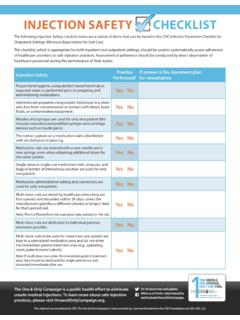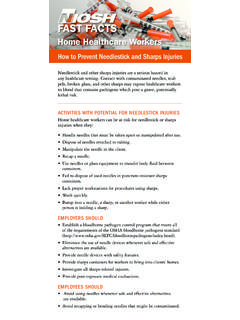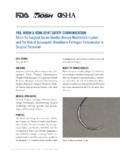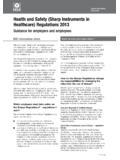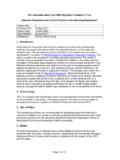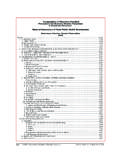Transcription of Training Activity. - One and Only Campaign
1 Safe Injection Practices Coalition Bloodborne Pathogens Training activity | TRANSCRIPT Page 1 Slide 1 Welcome to Safe Injection Practices: Protecting Yourself and Your Patients. A Bloodborne Pathogens Training activity . This Training will provide you with important injection safety information and resources that will help you, your colleagues, and your patients avoid the risk of infection from bloodborne pathogens. Click on the bracketed reference numbers to view the references for this module. Click the Next button to advance the lesson. Slide 2 This Training activity is supplemental to the required annual bloodborne pathogens Training for physicians, nurses, emergency and other medical technicians, aides, and assistants who are charged with the care of patients. The material reviewed here is especially important for any healthcare provider who prepares or administers injections to patients. The Occupational Safety and Health Administration, or OSHA, requires Training in the epidemiology of bloodborne pathogens and mitigating healthcare personnel exposures.
2 Healthcare provider and patient protections go hand in hand measures that healthcare providers take to protect themselves from bloodborne pathogens and other infection exposures also protect patients from healthcare-associated infections. Slide 3 Unsafe injection practices pose risks to both patients and healthcare providers. Bloodborne pathogens and other serious infections are readily spread by the improper use of syringes, needles, and medication vials. This has been demonstrated time and again in outbreak investigations conducted by the Centers for Disease Control and Prevention, or C-D-C, and state and local health departments. This map displays over 40 outbreaks associated with unsafe injection practices in healthcare settings from 2001 through June 2012. Many hundreds of patients were documented as having become infected in these outbreaks. Many more outbreaks likely go unrecognized, and the problem is suspected to be more widespread than is currently understood.
3 Safe Injection Practices Coalition Bloodborne Pathogens Training activity | TRANSCRIPT Page 2 Unsafe injection practices put patients and healthcare providers at risk of infectious and non-infectious adverse events. These practices have been identified in a wide variety of procedures and settings. Two points bear emphasis here: First, this harm is entirely preventable. Second, injection safety is every provider s responsibility. Keep yourself, your peers, and your patients safe. Slide 4 Patient and provider impacts go beyond the identified outbreaks and documented infections. Improper use of syringes and needles has also resulted in: (1) subsequent notification of thousands of patients of their potential exposure to bloodborne pathogens, advising that they undergo testing for hepatitis B, hepatitis C, and H-I-V; (2) referral of providers to licensing boards for disciplinary action; (3) malpractice suits filed by patients; and (4) the loss of public confidence in healthcare institutions.
4 [1][2] These unfortunate events serve as a reminder of the serious consequences of the failure to maintain strict adherence to safe injection practices during patient care. Slide 5 Let s review some terms and definitions that are used throughout this Training module. Click on an image or term to read its definition. Bloodborne pathogens are infectious microorganisms that may be present in human blood and that can cause disease in humans. These pathogens include, but are not limited to, hepatitis B virus, or H-B-V; hepatitis C virus, or H-C-V; and human immunodeficiency virus, or H-I-V. Infections can be transmitted when human blood or body fluid comes in contact with the bloodstream, mucous membranes, or non-intact skin as a result of an injection, infusion, splash, needlestick , cut, or sharps injury. Healthcare providers are healthcare workers and personnel charged with the care of patients, including those providing injections to patients.
5 Healthcare providers include physicians, nurses, medical technicians, aides, attendants, and other medical professionals, as well as students in Training and volunteers. Safe Injection Practices Coalition Bloodborne Pathogens Training activity | TRANSCRIPT Page 3 Safe injection practices are a set of measures to perform injections in an optimally safe manner for patients, healthcare providers, and others. As defined by the World Health Organization, a safe injection does not harm the recipient, does not expose the provider to any avoidable risks, and does not result in waste that is dangerous for the community. Slide 6 Safe injection practices are integral to Standard Precautions, a set of guidelines issued by C-D-C. Standard Precautions are the minimum infection prevention practices that apply to all patient care, regardless of the suspected or confirmed infection status of the patient, in any setting where healthcare is delivered.
6 [3] These practices are aimed at protecting patients as well as healthcare providers from the spread of infections. Standard Precautions include hand hygiene; use of personal protective equipment, such as gloves, gowns, and masks; safe injection practices; safe handling of potentially contaminated equipment or surfaces in the patient environment; and respiratory hygiene and cough etiquette. Slide 7 Across healthcare, the greatest risks for transmission of bloodborne pathogens occur in association with equipment such as medication vials, syringes, and needles that are used during the administration of parenteral medications. Intravenous injections and infusions involve contact with a patient s bloodstream. Thus, all materials that are used to deliver the medication such as syringes, needles, and I-V tubing are prone to blood contamination. Examples of procedures that fall into this category include flushing I-V lines or catheters and administering I-V medications such as chemotherapy and anesthesia.
7 Reuse of contaminated equipment, whether intentional or not, can expose patients to infectious blood. Bloodborne pathogen risks are also present with other types of injection procedures, including those involving intramuscular, subcutaneous, or other administration routes, as well as in blood collection procedures, including capillary fingerstick blood sampling. Safe Injection Practices Coalition Bloodborne Pathogens Training activity | TRANSCRIPT Page 4 Slide 8 Healthcare personnel may be exposed to bloodborne pathogens when they administer injections; for example, as a result of a needlestick injury. In general, risks increase with the volume of blood involved with the exposure. It is important to note, however, that even microscopic, invisible quantities of blood may be capable of causing an infection. C-D-C has estimated that each year, 385,000 needlesticks and other sharps-related injuries are sustained by hospital-based healthcare personnel.
8 To help healthcare facilities prevent needlesticks and other sharps-related injuries to healthcare personnel, C-D-C has developed the Workbook for Designing, Implementing, and Evaluating a Sharps Injury Prevention Program.[4] The workbook can be used by healthcare organizations to help design, launch, and maintain a sharps injury prevention program or to enhance existing activities and programs. Slide 9 Another significant but under-recognized workplace hazard pertains to injectable narcotics. Hundreds of patients worldwide have become infected with hepatitis C as a result of narcotics tampering by addicted healthcare providers. In the , outbreaks have been traced to swapping a used decoy syringe for an unused patient syringe filled with Fentanyl ahead of the patient s procedure. Believe it or not, some healthcare providers have become infected with bloodborne pathogens after they accessed used patient narcotics; for example, from diverting controlled substances such as Fentanyl following patient administration, even scavenging biohazardous waste.
9 All healthcare personnel must be vigilant for signs of possible diversion and do their part to maintain strict narcotics security along the entire supply chain, including safe, secure disposal.[5][6] Safe Injection Practices Coalition Bloodborne Pathogens Training activity | TRANSCRIPT Page 5 Slide 10 OSHA issued a Bloodborne Pathogens Standard in 1991 to support prevention of occupational exposure to bloodborne pathogens among healthcare personnel.[7] This regulation requires that all providers establish a bloodborne pathogens exposure control plan and update the plan annually. This entails a detailed review of procedures and care practices that could expose personnel to blood or other blood-contaminated fluids, substances, equipment, or materials. While not required, facilities may wish to consider integrating narcotics security into exposure control plans. The OSHA Standard also requires that all providers implement the use of Standard Precautions and treat all potentially infectious body fluids as if a bloodborne pathogen is present.
10 In November 2000, OSHA revised the Bloodborne Pathogens Standard to include the needlestick Safety and Prevention Act passed by Congress. This amendment mandates that employers must identify and use engineering controls, such as sharps with engineered sharps injury protection and needleless systems. Both CDC s Standard Precautions and the OSHA Bloodborne Pathogens Standard emphasize the use of personal protective equipment, such as gloves, gowns, eye protection, and masks. It is important for providers to remember that appropriate and consistent use of personal protection equipment is essential for their self-protection AND their patient s protection. An obvious example pertains to changing gloves (and performing hand hygiene) between patient encounters. Healthcare providers may feel that so long as they are wearing gloves, they are protected and may lose sight of the need to change gloves between patients. Another example was highlighted in a recent CDC Clinical Reminder stating spinal injection procedures performed without a facemask pose a risk for bacterial meningitis in patients undergoing the procedure.


